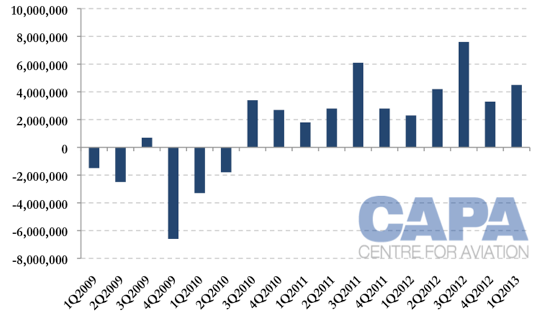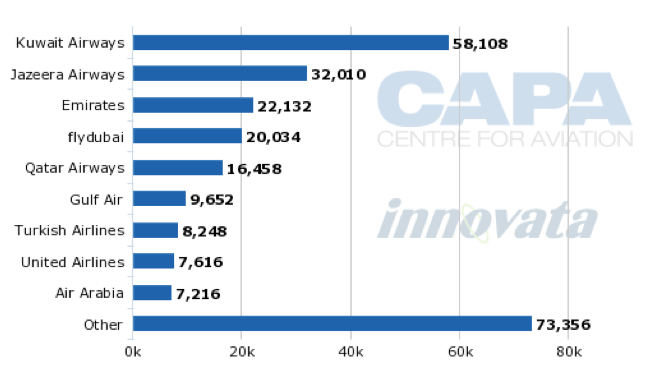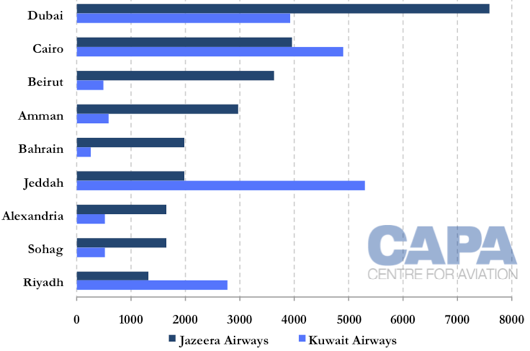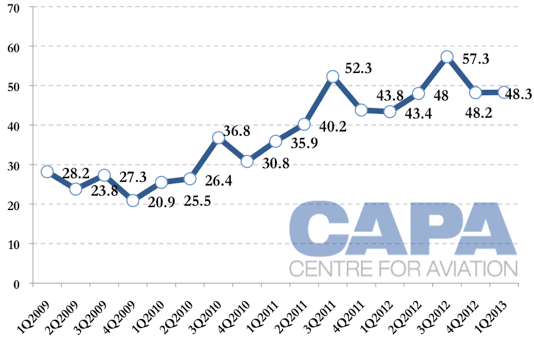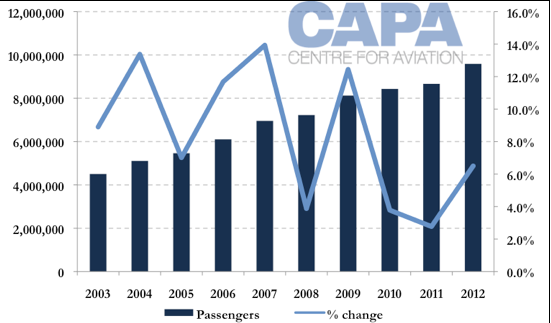Could Jazeera Airways, a small and nimble carrier, come to the rescue of Kuwait Airways?
In the Middle East, it may be impossible to find two carriers sharing a common hub that are more different than Jazeera Airways and Kuwait Airways. One is privately owned, nimble, low cost and highly profitable.
The other is government owned, suffering from decades of losses and burdened with overstaffing and bureaucratic detritus. However the future for both carriers may about to become linked. Jazeera Airways chairman Marwan Boodai has announced that the carrier is definitely interested in purchasing a stake in the national carrier once it launches its long delayed IPO.
In doing so, the small Jazeera may just provide a lifeline to the larger Kuwait Airways.
- Jazeera Airways, a privately owned low-cost carrier, is interested in purchasing a stake in Kuwait Airways once it launches its IPO.
- Jazeera Airways has been highly profitable, reporting a record profit of KWD13.9 million in 2012.
- Kuwait Airways, a government-owned carrier, has been suffering from losses and is burdened with overstaffing and bureaucratic issues.
- The acquisition of Kuwait Airways by Jazeera Airways could provide a lifeline to the struggling national carrier.
- Jazeera Airways' managerial expertise and successful turnaround efforts could benefit Kuwait Airways in terms of restructuring and fleet modernization.
- Private LCCs acquiring government-backed airlines have had limited success in the past, but Jazeera Airways is entering any potential transaction with caution.
Two airlines, two different stories in the same market
Jazeera Airways was launched in 2006 as the Middle East's first fully privately owned airline and the region's second low-cost carrier (after Air Arabia). In the past seven years, it has handled more than 28 million passengers. Its fleet of seven A320s operate a tightly controlled regional and international network, with an average flying time of just two and a quarter hours.
In 2012, the carrier reported a new record profit of KWD13.9 million (USD48.4 million), making it one of the world's most profitable airlines by size.
See related reports:
- Profits keep rolling but growth is elusive for Jazeera Airways
- Jazeera Airways and Air Arabia stick to their models and report double-digit increases in profits
Jazeera Airways quarterly profits: 2009 to 1Q2013
Kuwait Airways, the national carrier, has in contrast been operating since the mid 1950s, but its glory days are well behind it. The carrier suffered a major setback during and following the Iraqi invasion of 1990, and continued a two-decade long run of red ink in 2012, despite suspending its privatisation plan in 2011 as part of renewed efforts to stem the losses.
The Kuwait Airways fleet is one of the oldest in the Middle East and the carrier is cutting back its route network while rivals are expanding. It has suffered serious image problems at home and abroad due to maintenance and on-time performance issues.
Compared to other state owned airlines in the region, it is undersized, under-capitalised and offers a product well below the standard set by its world benchmark neighbouring competitors. While the national carrier handled 2.8 million passengers in 2011 with a fleet of 17 aircraft, Jazeera Airways managed to handle 1.2 million with just six aircraft. The national carrier still operates more capacity the Jazeera Airways at Kuwait International Airport - particularly given its long-haul routes to Europe, Southeast Asia and even New York - but, even despite a slowdown in its growth, the LCC is narrowing the capacity gap.
See related report: Kuwait aviation poised to deliver at last, but Kuwait Airways restructure, airport upgrade essential
Kuwait International Airport capacity (seats): 22-Apr-2013 to 28-Apr-2013
Kuwait Airways privatisation: An opportunity for Jazeera Airways and Kuwaiti aviation?
Kuwait Airways Corporation was turned into a shareholding company in Oct-2012. In Jan-2013, the Kuwait parliament gave its final approval of the carrier's privatisation legislation. Under the privatisation legislation, 35% of the carrier's shares would be sold off to local private investors, or to foreign investors; 40% would be allocated for sale to Kuwaiti nationals through an IPO; 5% would go to the employees share ownership trust; and the Kuwaiti government would retain a 20% strategic holding in the carrier. The privatisation process is expected to take up to three years.
In addition to the privatisation legislation, the Kuwait National Assembly also agreed to underwrite the airline's heavy losses. Kuwait Airways is estimated to have lost approximately USD560 million over the past two financial years alone. Kuwaiti Minister of Communications and Housing Salem Al-Othaina reported in late 2012 that the carrier had accumulated losses of USD1 billion over a four-year period. However, it did receive a USD500 million injection at the end of 2012, after Iraq and Kuwait settled a long dispute over damages to the carrier's fleet and infrastructure during the Gulf War. It has also received approximately USD635 million in loans.
See related report: Kuwait Airways and Iraqi Airways face brighter future following settlement of long-running dispute
According to Mr Boodai, Kuwait Airways has virtually abandoned the long-haul market, ceding the territory to the Middle East's large and fast expanding sixth freedom carriers. Instead, the national carrier has opted to divert some of its capacity back into regional operations, something that Mr Boodai sees as hurting Jazeera Airways. The Jazeera Airways chairman sees great potential synergies between the airlines, with the national carrier responsible for long-haul operations and Jazeera handling regional services and other short-haul destinations.
Kuwait Airways' uncertain financial position will be a sticking point, whoever buys
A major sticking point is Kuwait Airways' uncertain financial position. Before any investment goes forward, Jazeera would need to perform detailed due diligence. While Kuwait Airways' losses are being covered by the Kuwaiti Government, the issue is internal; but Jazeera Airways would only be interested in the carrier "provided the financials are right". Mr Boodai said Jazeera Airways may use its own cash for the proposed purchase, or may raise funds from the market.
A combined Jazeera Airways-Kuwait Airways operation could be highly complementary, solving several problems for both carriers. For Jazeera, it would stop the national carrier dumping capacity into short-haul markets, as well as providing it with a high-low product mix, probably dedicating Kuwait Airways to longer-haul operations while it handles the short-to-medium-haul markets.
At present, the carriers compete on nine Middle East regional routes, but Jazeera Airways' policy has been to make sure it has a significant proportion of the market on all but the largest routes it operates.
Jazeera Airways and Kuwait Airways capacity (seats) on regional routes: 22-Apr-2013 to 28-Apr-2013
Acquiring Kuwait Airways would also give the carrier tremendous international access. Although Kuwait has an open skies policy, Jazeera Airways CEO Stefan Pichler complained that the Middle East aviation market still suffers from protectionism and needs to "overcome national sensitivities", calling for the region to "develop a real open skies policy" to deliver its true growth potential.
For Kuwait Airways, the funds from the privatisation would help it with its own restructuring and a much needed fleet modernisation effort. Kuwait Airways intends to lease 10-12 aircraft to meet its short term needs, and expect to make an order for around 20 within the next two years.
Jazeera Airways' managerial expertise would also be invaluable for the carrier, particularly given the LCC's successful turn-around efforts over 2009 and 2010 under Mr Pichler. The then-struggling carrier underwent a profound realignment during this time, downsizing its staff and fleet and raising profitability to record levels while returning to growth. A merged entity, or at least cooperation between the two airlines, would also give it sufficient size to meet competition from some of the region's other small national carriers that are striving with their own turn around efforts, such as Gulf Air and Oman Air.
Private LCCs buying government-backed airlines offer a limited success story
A private and successful LCC buying a national carrier is unusual, but it is not unprecedented. In 2007 Brazilian LCC GOL bought out legacy flag carrier Varig after the fading national carrier had fallen into bankruptcy, been split up and faced liquidation. The carrier has since been fully incorporated into GOL's operations. But not without considerable indigestion; GOL would perhaps not repeat the experience if it had the opportunity again.
Irish LCC Ryanair has made repeated attempts to buy control of national carrier Aer Lingus over several years, although the Irish Government part-owner and the European Commission have rejected the efforts. In the case of the Irish airlines, it is the low-cost carrier that is the dominant partner in the market.
Malaysia-based LCC Air Asia was interested in investing in Malaysian Airlines, although a proposed share-swap agreement between the two was abandoned in early May-2012, to be replaced by a more limited collaboration agreement. The initial experience was not fruitful, thanks to a combination of political and corporate cultural issues.
Aer Lingus, where Ryanair control now looks extremely unlikely, is the only airline among these which is, or was, operating profitably. For a private airline to take on a loss making, legacy, government-owned, heavily politiicised airline is no small venture. So Jazeera will be entering any such transaction with its eyes wide open.
Jazeera is building on its successful turnaround, improving yield and load factor
After losses in 2009 and the first half of 2010, the carrier launched its turn-around plan - known as TAP - and cut capacity back heavily, slashing its network and staff. The result has been a record run of profitability - 11 quarters of positive results and counting. In 1Q2013, the carrier reported a net profit of KWD3.6 million (USD12.6 million), a record for the first quarter for the carrier and up 230% on the 1Q2012 net result. It has now moved beyond TAP and is progressing with STAMP - which lays out the carrier's strategy for 2013 and 2014.
STAMP is aimed at increasing the profitability of Jazeera's operation without any major additions in destinations, aircraft or other costs. Its premise is increased profitability through a combination of load factor and yield enhancements, resulting in additional revenues. STAMP's overarching goal is to increase the airline's load factor to 68% by 2014.
The turn-around of Jazeera Airways is one of Middle East aviation's great success stories. After its launch, the carrier overextended itself and was caught short when fuel prices rose, global economic conditions changed and capacity flooded into the Kuwaiti market. In 2009, it was ejected from its second hub at Dubai - to make way for the Dubai-based flydubai low cost operation - forcing upon it a major reorganisation of its operations. The result was the carrier's previous four-year run of profitability turning into two consecutive years of losses.
Under the TAP programme, the carrier cut its fleet to six aircraft - as well as cancelling an order for 25 aircraft - and reduced its network to 19 destinations, most of them less than three hours flight time from Kuwait. Faced with overcapacity at its home hub, the carrier concentrated on improvements in revenue and yields at the expense of passenger volume. Load factors have risen significantly, from a dismal 44% in 2010 to 51% in 2011 and then to 66% in 2012.
Yield management has been a key driver for Jazeera Airways. Capacity management and network nimbleness - as typified by the carrier's rapid exit from Syria - as well as a very short booking cycle have contributed to the positive yield performance. Enhanced service offering, including improved baggage allowances, better business class offerings and free on-board meals have also enhanced yields.
The result is that yields have doubled over a four-year period, driving revenue up strongly even when faced with falling passenger traffic due to capacity cuts.
Jazeera Airways yield (Kuwaiti fils): 1Q2009 to 1Q2013
Its Sahaab leasing unit has generated revenue and allowed greater capacity flexibility
Also crucial to the success of the turn-around was the carrier's Sahaab leasing unit, which granted it great flexibility to its operations, allowing the carrier to channel its excess capacity, turning them into highly profitable assets. Originally launched as a joint venture partnership with NBK Capital, Jazeera Airways took sole ownership of the leasing unit in Feb-2010, investing KWD25.6 million (USD).
In 2010, Sahaab took nearly half of the Jazeera Airways fleet, leaving the carrier with a half dozen of the newest aircraft. The older A320s were leased out to several carriers, including Virgin America and SriLankan Airlines. The leasing unit provided steady revenue to offset the seasonality of the group's airline business, and excellent profitability. Early on in the Jazeera Group turn-around effort, Sahaab leasing accounted for only 24% of the group's revenue, but 52% of its net profits.
Today though, Jazeera Airways is the group's primary profit earner. In 2012, the mainline airline was responsible for 59% of the group's net profit, and 76% of total revenue. In 1Q2013, traditionally the weakest quarter for the airline, it still managed to contribute 60% of group profitability.
Jazeera's slow and steady development path - and popularity with financial markets
Outside the possible investment in Kuwait Airways, Jazeera is taking a slow but steady development path, focusing on cost minimisation and efficiency rather than expansive passenger growth to achieve improvements in its bottom line. The carrier's STAMP plan is focused on maintaining the carrier's core network of less than 20 destinations and increasing density and capacity for growth. Under Jazeera's cautious fleet expansion, just three aircraft are due to come to the carrier over the next two years and it has not given much away about possible new orders. As it receives new aircraft, it will lease out the older aircraft via Sahaab.
The carrier's late 2012 rights issue to fund its remaining aircraft acquisitions and increase its capital was 2.25 times oversubscribed. The carrier sold 178 million shares, effectively raising the company's capital by 74% to KDW42 million (USD148 million). It now has a healthy balance sheet, with KWD47 million (USD165 million) in liquidity. It has also sought European credit agency funding to help with its A320 purchases.
For 2013, traffic growth will be focused around improvements in load factor and via increasing frequency across the existing network, particularly the more recently added routes such as in Egypt and Iraq. The carrier is also concentrating on improved operational efficiency, although its young, single type fleet already gives it high aircraft utilisation and fast turn-around times.
The Kuwaiti market shows very strong growth indicators for travel within the region, and Jazeera Airways' outlook for travel in the country is positive. Kuwait is a point-to-point market, which suits the airline's business model and comparatively simple, localised product.
Traffic at its Kuwait International Airport base has grown from around six million in 2006 to 9.5 million in 2012. Jazeera reported stronger than usual traffic growth in early 2013.
Kuwait International Airport passenger traffic:
Kuwaitis have increasing amounts of disposable income and are showing increasing inclination to travel. Jazeera Airways is looking to improve its marketing and increase leisure travel, focusing on quality service in all its cabins. It is also aiming at capturing a better share of the business market, and is tailoring its product to offer more for premium passengers.
Jazeera Airways expects moderate growth in 2013 and in 2014, when STAMP ends. Beyond that, the carrier is content to remain a small, nimble operator in a region dominated by large, government owned carriers. Its focus is on delivering growing profitability, and returns to its shareholders, rather than replicating the rapid passenger growth of other carriers in the region.
